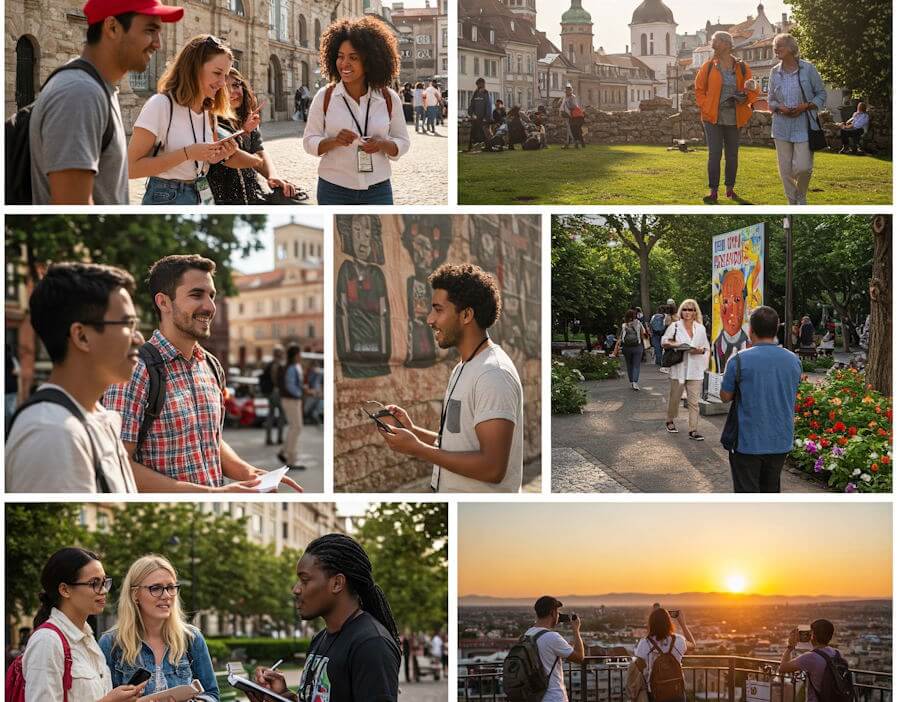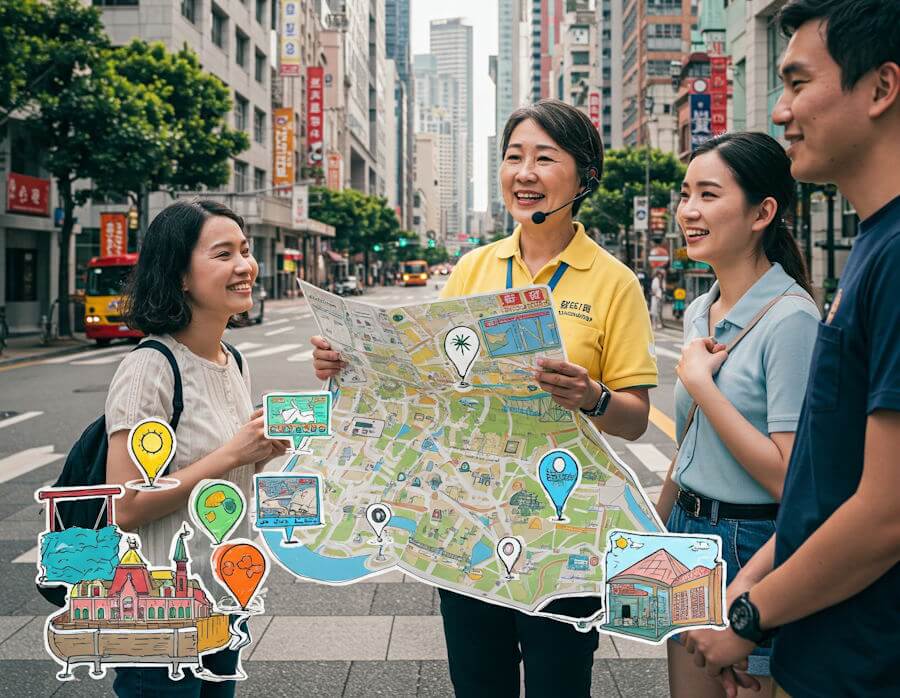Introduction to City Tour Branding
In today’s competitive tourism landscape, establishing a unique brand for your city tour is crucial for attracting visitors and fostering customer loyalty. City tour branding encompasses the strategic development of a brand identity that resonates with potential tourists, differentiating your offerings from others in the marketplace. A well-defined brand serves as a powerful tool to convey the values, experiences, and emotions associated with your city tours, thus influencing the decision-making process of potential customers.
Branding goes beyond merely selecting a catchy name or a vibrant logo. It involves a deep understanding of the target audience, the unique selling propositions of the tours, and the overall experience you intend to provide. For instance, a city tour that focuses on historical landmarks may highlight storytelling and immerse participants in the cultural heritage of the area. Conversely, a tour that emphasizes food or adventure will utilize different branding elements to attract those specific audiences. Such tailored branding can significantly enhance a tourist’s perception, leading to memorable experiences that increase the likelihood of repeat bookings and word-of-mouth referrals.
Moreover, in an era where consumers are more empowered than ever, establishing a strong brand identity helps foster an emotional connection with potential tourists. This branded relationship can translate into loyalty, where tourists choose your city tour over competitors simply based on the reputation you cultivate. Consequently, an effective branding strategy can contribute immensely to profitability and sustainability in the tourism sector. Thus, understanding the intricacies of city tour branding becomes not only advantageous but essential for businesses seeking to thrive in a crowded market.
Understanding Your Target Audience
Effectively building a brand around your city tour is heavily reliant on a deep understanding of your target audience. Identifying who your potential customers are allows you to shape your offerings and marketing strategies in accordance with their preferences, interests, and demographics. For city tours, audiences can vary widely based on age groups, travel motivations, cultural backgrounds, and leisure activities, making it crucial to gather sufficient data about them.
Age demographics play a significant role in shaping your brand. Millennials, for instance, may seek immersive, adventure-driven experiences and favor social media-driven recommendations, while older generations might prefer comfort and historical insights. Understanding these differences allows you to tailor your branding message accordingly. Additionally, the interests of travelers can greatly vary; some may prioritize culinary experiences, while others may lean towards historical sightseeing or eco-tourism. Knowing these intricate details about your audience not only enhances the attractiveness of your brand, but also engenders loyalty among your customers.
Conducting thorough market research is imperative to gain insights into the preferences and behaviors of potential customers. Utilize surveys, focus groups, and social media analytics to gather qualitative and quantitative data regarding travel preferences and expectations. Engaging with online communities related to travel and your specific city can also yield valuable information. Additionally, analyzing competitors and their strategies can offer crucial hints about unmet needs within the market, thus enabling your brand to fill those gaps effectively.
In conclusion, understanding your target audience is a foundational step in building a successful brand around your city tour. By leveraging demographic insights and preferences, you can create a compelling brand narrative that resonates with your customers, ultimately enhancing their experience and satisfaction. Tailoring your efforts based on market research not only brings clarity to your branding strategy but also fosters lasting relationships with your audience.
Defining Your Unique Selling Proposition (USP)
In the competitive landscape of city tours, defining your Unique Selling Proposition (USP) is imperative to distinguish your offerings from others. A well-articulated USP highlights what sets your tour apart, whether it is historical insights, intimate local experiences, or exclusive access to attractions not available through other providers. This distinctive quality should resonate throughout your branding and marketing strategies.
To identify your USP, start by conducting thorough research on existing city tours in your area. Evaluate competitors by examining their offerings, target audience, and marketing messages. This will enable you to uncover gaps in the market and areas where your tour can excel. Perhaps your tour emphasizes sustainability, providing eco-friendly transport solutions or highlighting local artisans’ work, which might be overlooked by competitors. Engaging with customers through surveys or interviews can also yield rich insights into what they value the most during a city tour.
Once you have determined your USP, the next step is communicating it effectively through various branding elements. Your logo can reflect the essence of your tour, incorporating local symbols or colors that resonate with the destination. For instance, if your tour focuses on historical landmarks, consider using imagery that represents the city’s unique architecture. Furthermore, a captivating slogan can succinctly encapsulate your USP; it should be memorable and convey the main benefit to the customer clearly.
In addition to visual branding, integrate your USP into your marketing messaging. Whether through website content, social media posts, or promotional materials, ensure that your unique qualities are front and center. This consistency will build a recognizable brand identity, establish trust with potential customers, and ultimately attract a dedicated audience for your city tour.
Creating a Memorable Brand Identity
Establishing a memorable brand identity is crucial for any city tour business aiming to stand out in a competitive market. A strong brand identity encapsulates who you are, what you offer, and how you connect with your audience. One of the primary components of a brand identity is visual elements such as logo design, color schemes, and typography. The logo serves as the face of your brand, and its design should be simple yet convey the essence of your tours. Every element, including colors and fonts, should reflect your brand’s personality and mission, contributing to an overall cohesive appearance.
In addition to visual elements, consistency across all platforms is paramount for reinforcing your brand’s identity. This means that your website, social media profiles, and printed materials should all present a unified image. By maintaining this consistency, you not only enhance brand recognition but also build trust with potential customers. When individuals encounter your branding repeatedly in the same manner, they are more likely to remember you when it comes time to book a tour.
Moreover, developing a distinctive brand voice and personality can significantly enhance the connection with your audience. Your brand voice should reflect the values and tone of your city tour, whether that be informative, adventurous, or friendly. Crafting a narrative that resonates with your audience allows them to engage with your brand on a deeper level. Understanding your target demographic can help tailor your messaging, ensuring it speaks directly to their interests, desires, and needs.
Combining these elements—visual identity, consistency, and brand personality—will create a compelling brand that captures the essence of your city tours and fosters lasting relationships with your customers.
Enhancing the Customer Experience
Creating a memorable customer experience is essential for building and reinforcing your brand within the city tour industry. Every interaction, from the initial booking to the post-tour communication, contributes to how potential customers perceive your brand. Engaging with customers at multiple touchpoints allows you to create a cohesive and valuable experience that resonates with them long after the tour has ended.
One effective strategy is to offer personalized services. By tailoring the tour experience to the individual preferences and needs of your customers, you convey that you value their participation. This can be achieved through pre-tour surveys that gather information on their interests, enabling you to showcase the most relevant attractions or activities during the tour. Personalized touches, such as a welcome note or a small gift related to the tour theme, can leave a lasting impression, enhancing the connection between the customer and your brand.
Providing exceptional customer service is another vital aspect of enhancing the experience. A knowledgeable and friendly guide who engages with the tour group enriches the experience and reinforces the brand’s reputation for quality service. Ensuring that tour staff is well-trained in communication skills and customer engagement tactics further solidifies this approach. Encouraging outgoing and positive interactions helps foster a welcoming environment that makes customers feel valued and appreciated.
Collecting feedback post-tour is critical for continuous improvement and solidifying brand loyalty. A simple follow-up survey can provide valuable insights into customers’ experiences, allowing you to identify areas for enhancement. Moreover, demonstrating that you listen and act upon their input establishes trust and shows that you prioritize their satisfaction. Ultimately, by focusing on every element of the customer experience, you not only build a robust brand image but also encourage repeat business and customer referrals.
Leveraging Digital Marketing Strategies
In today’s digital age, leveraging effective digital marketing strategies is essential for promoting your city tour brand. A well-rounded approach incorporates various elements such as social media marketing, search engine optimization (SEO), content marketing, and online advertising. Each of these components plays a crucial role in establishing brand awareness and attracting potential customers.
Social media marketing is an indispensable tool for connecting with your audience. Platforms such as Facebook, Instagram, and Twitter allow you to share engaging content, including photos and videos showcasing the highlights of your city tours. By frequently interacting with followers and utilizing compelling storytelling, you can create a community around your brand. Additionally, leveraging user-generated content can further enhance your credibility and encourage sharing among customers, effectively amplifying your brand’s reach.
Search engine optimization (SEO) is another vital aspect that can significantly impact your online visibility. By optimizing your website for relevant keywords related to city tours, you increase the likelihood of appearing in search results when potential customers seek out experiences in your area. This includes using local SEO strategies, such as incorporating location-based keywords, to attract tourists planning their visits.
Content marketing serves as a vehicle for storytelling that resonates with your audience. Engaging blog posts, articles, and infographics that detail the unique aspects of your city tours can establish your brand as a trustworthy authority in the travel industry. Additionally, high-quality visuals and well-written content have the capacity to capture the attention of prospective customers effectively.
Finally, online advertising can provide a significant boost to your marketing efforts. Pay-per-click (PPC) campaigns, social media ads, and display advertising can target specific demographics, helping to drive traffic to your tour website. When combined with captivating visuals and clear calls to action, these advertisements can generate substantial interest in your tours.
Building Partnerships and Collaborations
Establishing partnerships and collaborations with local businesses and organizations can significantly elevate the branding of your city tour. These strategic alliances not only enhance your service offerings but also amplify your marketing reach. By combining resources, knowledge, and networks, you create a unique value proposition that can attract a broader audience and improve customer experience.
One of the key advantages of forming partnerships is the increase in visibility. Collaborating with local businesses, such as restaurants, hotels, and attractions, allows for cross-promotion. For instance, if a dining establishment promotes your city tour on its website or through its social media channels, you gain immediate access to its clientele. This reciprocal promotion can lead to increased inquiries and bookings for your tours. Furthermore, local organizations, such as art galleries or historic societies, can offer exclusive events or discounts to your customers, enhancing the overall tour experience and providing added value.
Successful partnerships often arise from clear communication and mutual benefits. It is crucial to approach potential collaborators with a well-defined proposal that outlines how the partnership will be advantageous for both parties. You might consider co-hosting events, creating exclusive packages, or developing joint marketing campaigns that emphasize the uniqueness of your city and its offerings. Additionally, sharing customer feedback and success stories from the collaboration can help build trust and long-term relationships.
As you explore opportunities for partnerships, focus on those that align with your brand’s mission and values. Collaborating with organizations that share similar goals strengthens the authenticity of your offerings and fosters a sense of community among local businesses. Investing time in cultivating these relationships can lead to sustainable growth and a more robust brand presence in the competitive tourism market.
Gathering and Showcasing Customer Testimonials
In today’s competitive marketplace, gathering customer testimonials has become an essential strategy for businesses aiming to establish credibility and foster trust. Customer testimonials serve as social proof, demonstrating to potential clients the positive experiences of those who have previously engaged with your brand. This powerful form of marketing not only enhances your brand’s reputation but also encourages new customers to choose your services over others. Therefore, implementing an effective strategy for collecting, curating, and showcasing testimonials is crucial for building a strong brand around your city tour.
To begin, it is vital to identify the right moments to ask customers for testimonials. Timing plays a significant role; the best instances are often shortly after a memorable experience, when the positive emotions are fresh. Consider employing follow-up emails post-tour that express gratitude for participation while inviting customers to share their thoughts. Additionally, offering incentives, such as discounts on future tours or entry into a giveaway, can motivate customers to leave a review.
Once testimonials are collected, curating them effectively is key to maximizing their impact. Select those that highlight various aspects of your tour, such as customer service, unique experiences, and overall satisfaction. This diversity will resonate with a wider audience and address varying concerns. Furthermore, showcasing testimonials across multiple platforms is essential. Utilize your website, social media profiles, and review sites like TripAdvisor or Google Reviews to increase visibility. Creating visually appealing graphics featuring customers’ quotes can also elevate the presentation of these testimonials.
Sharing success stories through blog posts or video content can further enhance your brand’s image. Testimonials can be transformed into engaging narratives that convey the essence of your tours, enabling potential customers to visualize their own experiences. Overall, a well-structured approach to gathering and exhibiting customer testimonials can significantly boost your brand’s credibility, establishing a trusted identity within the city tour market.
Measuring Brand Success and Making Improvements
Assessing the success of your branding efforts is essential for a city tour business aiming to establish a lasting presence. Implementing well-defined key performance indicators (KPIs) is crucial in this assessment process. These metrics should focus on customer engagement, brand awareness, and conversion rates to provide a comprehensive overview of brand performance. For example, tracking the number of bookings, social media interactions, and customer referrals can help gauge the effectiveness of your branding strategies.
Analyzing customer feedback is equally important. Regularly collecting reviews, conducting surveys, and monitoring feedback across various platforms allows you to understand customer perceptions and experiences. By engaging with customers and encouraging them to share insights, you can gain valuable information regarding areas of improvement or aspects that resonate well. This two-way communication fosters a stronger relationship between your brand and the audience, which can lead to loyalty and repeat business.
Utilizing data to refine your branding strategies is an ongoing process. Analyzing trends in customer behavior can highlight changing preferences in the tourism sector, allowing your brand to adapt accordingly. Moreover, implementing A/B testing for marketing campaigns can provide insights into which approaches yield the best results, enabling you to optimize your messaging effectively.
It is also important to remain vigilant and adaptable in today’s dynamic market environment. Regularly reviewing your brand’s positioning, visual identity, and messaging helps ensure alignment with evolving customer expectations. Incorporating ongoing market analysis will further empower your city tour brand to evolve, thereby maintaining a competitive edge and resonating with your target audience. Ultimately, measuring success and making well-informed improvements is key to developing a robust brand that thrives over time.




